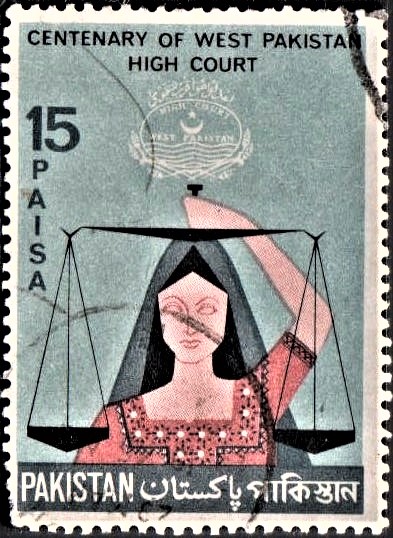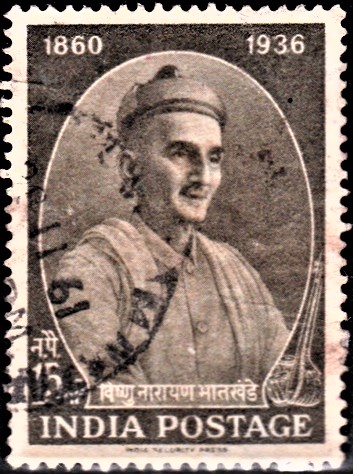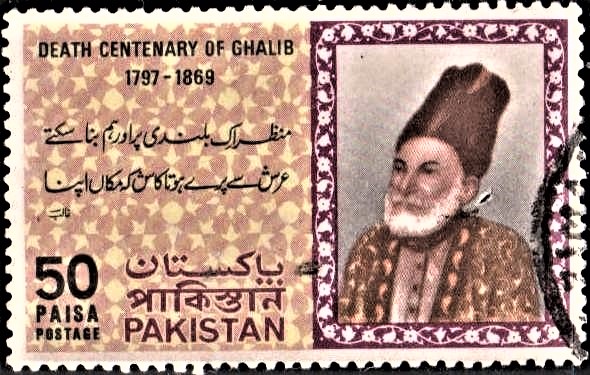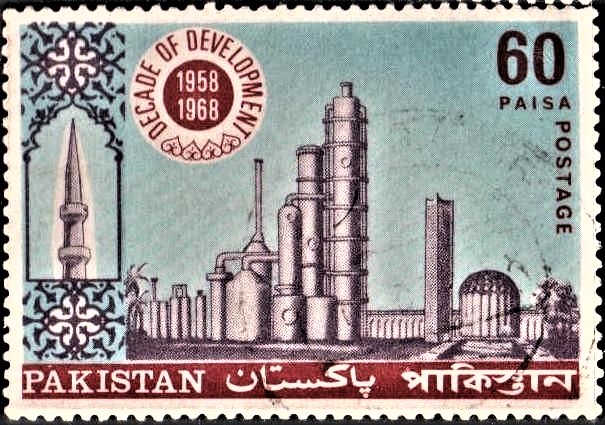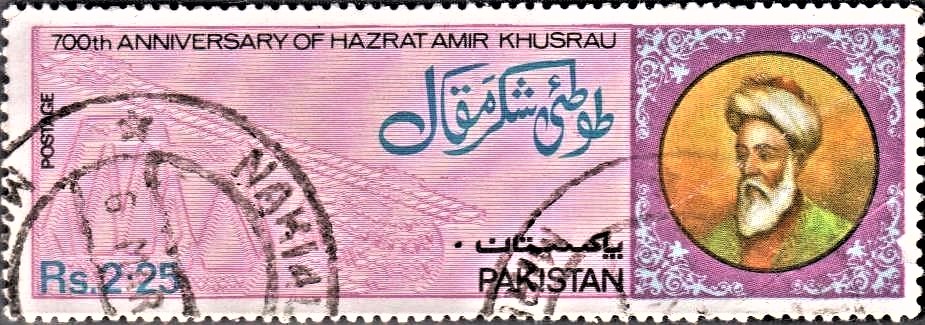
Pakistan on Amir Khusrau
Complete set of 2 nos. of commemorative postage stamp on the 700th Anniversary of Hazrat Amir Khusrow, a Sufi mystic-musician and a spiritual disciple of Nizamuddin Auliya of Delhi :

 Issued by Pakistan
Issued by Pakistan
Issued on Oct 24, 1975
Issued for : Amir Khusrau‘s political portraiture of life and the sublime emotions which found expression in his poetry and the music he composed have continued to entertain, and inspire generations of peoples for the last seven centuries. The Government and people of Pakistan are participating in the world-wide celebrations of 700th Anniversary of birth of this immoral Muse to pay our homage to this versatile genius and to affirm our faith in his noble message of humanism.
Description : The stamp is horizontal and rectangular in shape. Portrait of Hazrat Amir Khusrau appears in multi-colour in a circle inside a decorated square at the right side of the stamps.
Two musical instruments ‘Sitar‘ and ‘Tabla‘ invented by him appear in relief form in the blue tinted rectangular background at left. The inscription “![]() “ meaning ‘The bird of sweet notes’ appears at the top right portion of the rectangle.
“ meaning ‘The bird of sweet notes’ appears at the top right portion of the rectangle.
The denomination figure “20 P” appears in the lower left corner of the stamp in red.
The wordings “700th Anniversary of Hazrat Amir Khusrau” appear in black at the top of the rectangle while the words ‘Postage’ appears along side the left edge of the stamp.
‘Pakistan‘ in Urdu and English appear in black in the bottom right corner of the rectangle.
In the case of Rs. 2.25 stamp, the background in decorated square is in red colour while the inscription “![]() “ and Rs. 2.25 in blue.
“ and Rs. 2.25 in blue.
Designer : Adil Salahuddin
Type : Stamps, Postal Used
Denomination : 20 Paisa and Rs. 2.25
Colours : Magenta, Cyan, Yellow and Black
Size of Stamp : 26.7 m.m. x 78 m.m.
Size of Print : 23 m.m. x 74 m.m.
Perforation Gauge : 12½ x 13 c
Quantity : 5,00,000 of each denominations
No. of stamps in each sheet : 45 set
Process of printing : Litho Offset
Printers : The Pakistan Security Printing Corp. Ltd., Karachi
Name : Ab’ul Hasan Yamīn ud–Dīn Khusrau
Born on 1253 at Patiyali, Delhi Sultanate [now Patiyali, Kasganj District, Uttar Pradesh, India]
Died on Oct 1325 at Delhi, Delhi Sultanate
About :
- Amir Khusrau was born at Mu’min Pura (Patiyali) in the 651 of Hijra corresponding to 1252-1253 of the Christian era. He lost his father at the age of eight and came over to Delhi under the loving care of his maternal grandfather, Imad ul Mulk. He started composing poetry at the early age of twelve. When he was twenty he lost also his maternal grandfather and adopted Malik Chhajju, a nephew of the reigning monarch (Balban) and the most powerful noble at the Court of Delhi, as his temporal master. In the same year, i.e. 671/1272-73, he published the first anthology of his poetic compositions which he aptly named Tuhfat–us–Sighar (‘The Gift of Youth‘).
- The poet, then entered the court of Prince Mohammad, the son of Balban who was Governor at Multan and served there for about 5 years. Prince Mohammad who was one of the most accomplished princes – valiant urbane and cultured was a great patron of poets and men of letters. He greatly honoured Amir Khusrau in his court and gave him proper recognition. When prince Mohammad was killed in a battle with Tartars who had attacked Lahore and Multan, Amir Khusrau composed a heart rending elegy on the prince’s death and return to Delhi.
- The poetic compositions of this period were collected by him in the anthology named Wast–ul–Hayat (‘The Middle of Life‘).
- The poet then entered the service of Governor, Oudh but to the great relief of his mother whom he loved immensely, he returned to Delhi which saw a succession of monarchs and a frequent change of dynasties. While court intrigues and palace revolutions were a normal feature of the political life of those troubled days, there was a firm sheet-anchor of moral values in sufi hospice of Hazrat Sultan Nizam-ud-Din Auliya. Amir Khusrau‘s primary loyalty was to the great saint and to the values for which the saint had devoted his life. But at the same time kept in touch with the court. He did not owe allegiance to the person of the ruling monarch but he considered himself duty bound to the Crown.
- Of his Persian poetry, as well, not all but certainly the largest part of it, has come down to us in very well-arranged and authenticated versions. He tried his hand in all the branches of Persians poetry, Ghazal, Masnawi, Qasida, Rubai and Tarjiat, and having excelled in all of them stands unique and unparalleled in the whole history of Persian poetry.
- a. Diwans
(Collection of Poems and Ghazals)- i) Tohfatus Sighar
(comprising poems written at the age of 16-19) - ii) Wastul Hayat
(poems written at the age of 20-32) - iii) Ghuarratul Kamal
(poems written at the age of 34-43) - iv) Baqiah Naqiah
(poems written at the age of 50-64) - v) Nehayatul Kamal
(poems written during the last part of his life)
- i) Tohfatus Sighar
- b. Masnawis
- i) Matla–ul–Anwaar
(An exposition of Islamic values) - ii) Shireen–o–Khusro
- iii) Laila–o–Majnon
- iv) Aina–i–Sikandari
(An epic comprising episodes from the war between Chinese emperors and Sikandar.) - v) Hasht Behisht
(Story of Romance between Dilaaram and Behram Guar) - vi) Qiranus Saadian
(An epic devoted to glorification and description of reconciliatory episodes between Bughra Khan and Kaiqobad) - vii) Miftahul Fatuh
(eulogy of Feroz Khilji) - viii) Davalrani Khizr Khan
(Story of a love between Prince Khizr Khan & Devalrani) - ix) Noh Sepehr
(Description of a quarrel between Mubarak Khilji and Prince Khusro Khan) - x) Tughlaq Nama
(Description of the region of Ghiasuddin Tughlaq).
- i) Matla–ul–Anwaar
- c. Prose
- i) Aijaz–e–Khusravi
(A commentary on contemporary styles of Persian prose with an exposition of Khusrau‘s own style) - ii) Khazainul Fatuh
(A description of historical victories) - iii) Afzalul Fawaid
(A collection of Sayings of Hazrat Nizamuddin Auliya).
- i) Aijaz–e–Khusravi
- d. Miscellaneous
- i) Nisab Badiul Ajaib,
- ii) Gharyal,
- iii) Shehr–e–Asohobe,
- iv) Khaliq Bari
(Ancient Urdu Poetry) - v) Risala Cheestan
(A collection of enigmas).
- a. Diwans
- His prose is much too ornate and full of literary artifices some of which were his own innovations. However, they contain gems of literary criticism. Though he chose poetry as a vehicle for his historical writings, his place as the most accurate historiographer of his times is assured.
- He was a great musician and instrumentalist and the greatest composer of music that Muslim India has produced. Again, like his Urdu poetry, his original compositions have not been preserved but in the absence of the notation system in the music of the subcontinent it is not the least surprising. But he certainly pioneered the fusion of two highly developed traditions of Music: the Central Asian and the South Asian.
- He was the bridge, the cultural catalyst, the harmonizer and the humanist. Above all, he was a Man: a Great Man.
- Issued by: The Director-General, Pakistan Post Office, Karachi.


